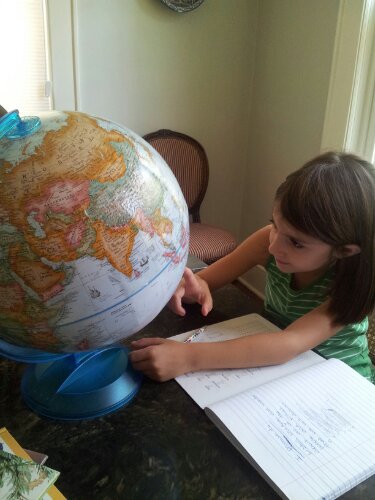We start week 6 feeling a bit of relief that we are on to Australia — with so many fewer counties and cultures than Asia, Africa and Europe, we think it will be a bit more manageable to learn about in a week! Afterall, we share the same language and much the same traditions and cuisine. But things take a bit of turn when we pull out the atlases and globe…
We know that Australia is both a country and a continent, but learn that the continent is sometimes called Sahul, Australinea or Meganesia, to include the neighboring islands, which were once a part of the main island of Australia (Officially called the Commonwealth of Australia), until the land broke away thousands of years ago. From The Children’s World Atlas we learn that New Zealand and some of the nearby islands technically sit on a mainly submerged continent called Zealandia. Zealandia and the greater area of Australia combine into a region called Oceania or Australasia. Getting a bit more complicated than we thought!

For now we keep it simple and focus on the country of Australia. And actually the country itself keeps things straightforward by dividing along straight lines of longitude and latitude into 6 states–Western Australia, South Australia, Queensland, New South Wales, Victoria and the island of Tasmania. The terrain and culture are similar to America’s in many ways. There are dry areas in the center of the country (called the outback), and warmer areas by the coast. There are modern cities and smaller suburbs and towns, and lots of farming area. Just like in America, the British claimed and settled in Australia several hundred years ago and brought with them their traditions and religion. Although in Australia, it wasn’t until the early 1900’s that the six British colonies federated and became one nation, with the colonies officially becoming the states of the Commonwealth of Australia.
While there are many similarities between the US and Australia, it’s easy to spot some differences. From a fun book called Top to Bottom Down Under we read about some of them. As we already know, the water swirls the opposite direction when you flush the toilet in Australia. This, the kids think, is a little bit cool, but they think it’s a lot more cool to read about the trees that lose their bark each winter instead of their leaves. And then there are the birds that live in underground holes, like moles, and can swim under water like fish, but can not fly. And the seasons, which are completely reversed from ours. Christmas is celebrated at the beach! Since December is so cold for us in the northeast, this is starting to sound a bit like a Dr Seuss world to the kids!
We also learn that the English in Australia has many words that we might not be familiar with. Like hooroo means good-bye, jumbuck means sheep, and oldies means parents! We decide to say hooroo to Australia for the night and look forward to learning more about it tomorrow 🙂



